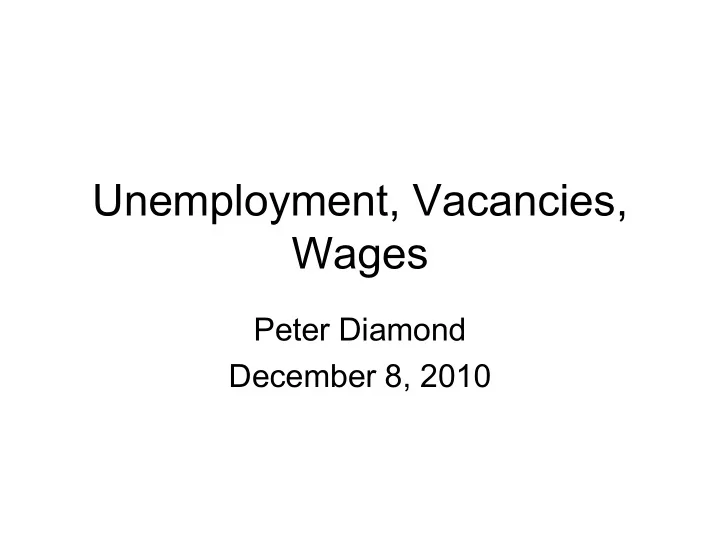

Unemployment, Vacancies, Wages Peter Diamond December 8, 2010
Outline • A retail market example • Labor market flows • Beveridge Curve • Research motivation
Monthly Worker Flow Rates, 1990:2 – 2009:4 (as a percent of workers with initial status) 40 37.1 32.9 30 20 10 4.3 3.6 2.7 1.9 0 UE UI IE IU EU EI Data constructed by Robert Shimer. For additional details, please see Shimer (2007) and his webpage http://sites.google.com/site/robertshimer/research/flows.
Average Monthly In- and Outflow Rates across Countries Source: Michael Elsby, Bart Hobijn, and Ay şegűl Şahin “Unemployment Dynamics in the OECD”, Federal Reserve Bank of San Francisco, August 2009, Figure 1.
Quarterly Job and Worker Flows for the U.S. Private Sector 1990:2-2009:4 (as a percent of employment) 18 15.5 15.3 16 Other, e.g. 1.0 Retirements 14 12 7.2 Quits 10 7.5 7.3 8 15.5 6 4 Layoffs 7.5 7.3 7.1 2 0 JOB CREATION JOB DESTRUCTION HIRES SEPARATIONS Notes: Series drawn from methodology used in Davis, Faberman and Haltiwanger (2010), “Labor Market Flows in the Cross Section and Over Time”. Series measured from Business Employment Dynamics (BED) and Job Openings and Labor Turnover Survey (JOLTS). Pre- 2001:3 Hires, Separations, Layoffs and Quits are Model Based Estimates. Source: John Haltiwanger, personal communication
Shift in Aggregate Activity (c) Source: Olivier Blanchard, Peter Diamond “The Beveridge Curve” Brookings Papers on Economic Activity , Vol. 1989 No.1., Figure 3.
Source: Robert Shimer, personal correspondence.
“What does this change in the relationship between job openings and unemployment connote? In a word, mismatch. Firms have jobs, but can’t find appropriate workers. The workers want to work, but can’t find appropriate jobs. … it is hard to see how the Fed can do much to cure this problem. … the Fed does not have a means to transform construction workers into manufacturing workers.” Source: Narayana Kocherlakota, President, Federal Reserve Bank of Minneapolis, “Inside the FOMC”, August 17, 2010.
Vacancy Yield, measured as H(t)/V(t-1) January 2001 ― September 2010 Source: Davis, Faberman and Haltiwanger, work in progress
Unemployed Persons by Duration of Unemployment Percent Distribution (Not Seasonally Adjusted) 50 40 38.0 30 43.9 20 21.9 20.3 19.8 21.8 10 17.5 16.8 0 Less than 5 weeks 5 to 14 weeks 15-26 weeks 27 weeks and over October 2009 October 2010 Source: Bureau of Labor Statistics, Economic News Release, November 5, 2010, Table A-12.
Recommend
More recommend